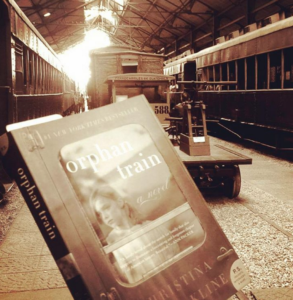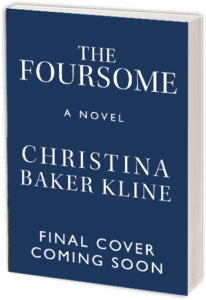- Did the people you met and the stories you heard at the Orphan Train Riders of New York reunion inspire any changes in the piece, and, if so, what?

- Was it common for train riders to keep their experiences secret?
- How did most train riders ultimately feel about having been put on a train?
- Why was it better for them to go to the Midwest? Can you tell us little bit about that aspect? What was waiting for them at the arrival in families?
- How did the idea come about to have the two characters’ necklaces echo each other?
- Did the people you met and the stories you heard at the Orphan Train Riders of New York reunion inspire any changes in the piece, and, if so, what?
I had just started writing the novel when I attended my first NY Train Riders’ reunion in Little Falls, Minnesota, and there’s no question that the stories I heard and the people I met influenced me as I wrote. As the train riders and their descendants stood up and told their stories it was clear that even the ones that ended happily were poignant, filled with loss. As one train rider said, you didn’t end up on a train unless you had a major trauma in your past. I realized that I had a responsibility in writing this book to be as emotionally and factually accurate as possible. I needed to get the tone and texture right.
- Was it common for train riders to keep their experiences secret?
Most of these children believed the train they were on was the only one, and that it wasn’t until the 1960s – usually at the urging of their own children – that they began to tell their stories.
- How did most train riders ultimately feel about having been put on a train?
I had just started writing the novel when I attended my first NY Train Riders’ reunion in Little Falls, Minnesota, and there’s no question that the stories I heard and the people I met influenced me as I wrote. As the train riders and their descendants stood up and told their stories it was clear that even the ones that ended happily were poignant, filled with loss. As one train rider said, you didn’t end up on a train unless you had a major trauma in your past. I realized that I had a responsibility in writing this book to be as emotionally and factually accurate as possible. I needed to get the tone and texture right.
- Why was it better for them to go to the Midwest? Can you tell us little bit about that aspect? What was waiting for them at the arrival in families?
The children often went into farming communities where labor was needed. Though many of them had hard lives, life on the streets of New York was often short and brutal. Though putting children on trains like this is unimaginable today, they probably ended up better off in the Midwest than they would’ve if they’d stayed in the Northeast.
- How did the idea come about to have the two characters’ necklaces echo each other?
When I start working on a novel I often have pre-conceived ideas about connections and themes that don’t actually pan out. The most resonant themes, I find, emerge in the writing of the book.
I didn’t originally intend to give both central characters in Orphan Train necklaces with metaphorical significance, and for a while I didn’t even consciously realize the connection between them.
In my research I learned that though children weren’t allowed to bring anything with them on the orphan trains, some did smuggle small keepsakes. These became increasingly important to them as the years went by. In Galway I went into the small corner shop where the Claddagh, a traditional Irish emblem with two hands encircling a heart, was invented and realized that I’d found my Irish-immigrant character Vivian’s keepsake. Later, researching Maine Penobscot Indian legends, I discovered that certain animals – a fish, a raven, a bear – have specific powers and talismanic significance. These, I knew, would be important to my half-Native American character, Molly.
